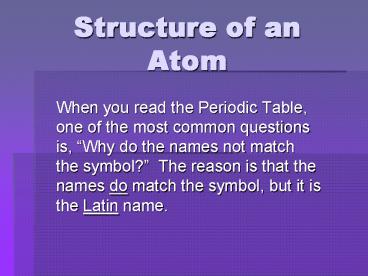Structure of an Atom - PowerPoint PPT Presentation
1 / 24
Title:
Structure of an Atom
Description:
Structure of an Atom When you read the Periodic Table, one of the most common questions is, Why do the names not match the symbol? The reason is that the names ... – PowerPoint PPT presentation
Number of Views:174
Avg rating:3.0/5.0
Title: Structure of an Atom
1
Structure of an Atom
- When you read the Periodic Table, one of the most
common questions is, Why do the names not match
the symbol? The reason is that the names do
match the symbol, but it is the Latin name.
2
Example
- Silver
- Symbol Ag
- Latin Name Argentum
3
Atomic Components
- An element is matter that is composed of one type
of atom, which is the smallest piece of matter
that still retains the property of the element.
4
The parts
- Atoms are composed of particles called
- Protons ()
- Neutrons (no charge)
- Electrons (-)
5
The Mass
- Protons and Neutrons are found in a small,
positively charged () center of the atom called
the nucleus that is surrounded by a cloud
containing electrons. - (If both protons and neutrons are found in the
nucleus, why is it positive ()?)
6
Diagram
- Protons positively charge 1
- Neutrons do not have a charge (o)
- Electrons negatively charge 1-
- Atoms of different elements differ in the number
of protons they contain.
7
New Material - Quarks
- Even Smaller
- Protons and Neutrons are made up of smaller
particles called quarks. Scientists have
confirmed the existence of six uniquely different
quarks. Scientists theorize that the arrangement
of three quarks held together with the strong
nuclear force produces a proton. 3 more makes a
neutron.
8
Quarks -
9
Quarks
- To find quarks, scientists accelerate charged
particles to tremendous speeds then force them to
collide with other protons.
10
Models
- Scientists use models to represent things that
are difficult to visualize, (that means see in
your mind)
11
Atoms
- Atoms are very small. It would take about 24,400
atoms staked on top of each other to equal the
thinness of a sheet of aluminum foil. - To study them, scientists developed models that
they can use to visualize how the atom is
constructed
12
The Model has changed.
- Democritus proposed the idea that atoms make up
all substance in - 400 B.C.
- But Aristotle disputed Democritus Theory saying
that all matter is uniform throughout and not
composed of smaller particles.
13
Aristotles Theory
- Aristotles Idea was accepted for over 2000
years. - See what happens when you dont study before you
say things. They tend to be WRONG!! - Anyhow, he didnt have the technology that we
have today either.
14
John Dalton
- In the 1800s John Dalton provided a model of the
atom as a solid sphere.
15
- But over time and experiments, scientists have
modified the atomic model. The model that we use
today is the accumulated knowledge of almost 200
years.
16
Thompson s Model
- The chocolate chip cookie model
- Whats missing?
17
Rutherfords Atom
- Whats missing?
18
Bohr Model
- Diagram like planets orbitals.
19
Electron Cloud
- Newest Model
20
Electron Cloud
- Developed in 1926, the electron cloud is the area
around the nucleus of an atom where its electrons
are most likely found. - The electron cloud is 100,000 times larger than
the diameter of the nucleus, but an electron is
much smaller than a proton
21
The atoms mass
- Proton 2000 times larger than an electron.
- Electrons the electron cloud makes up an atoms
volume. (space) Electrons are very tiny.
22
Why we dont see them.
- Because an electrons mass is small and the
electron is moving so quickly around the nucleus,
it is impossible to describe its exact location
in the atom.
23
What do electrons do?
- Each electron travels at an average distance form
the nucleus, depending on its energy. - These average distances are referred to as energy
levels. - Energy levels are areas of the cloud where the
electrons are more likely to be found.
24
Energy Levels































